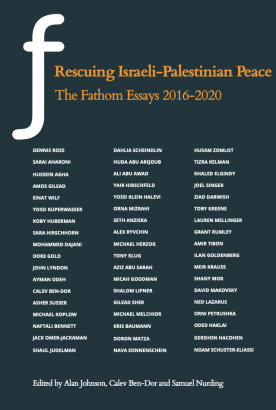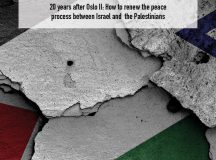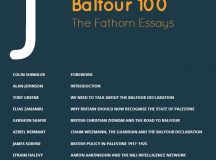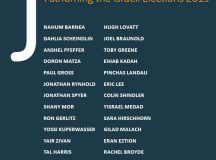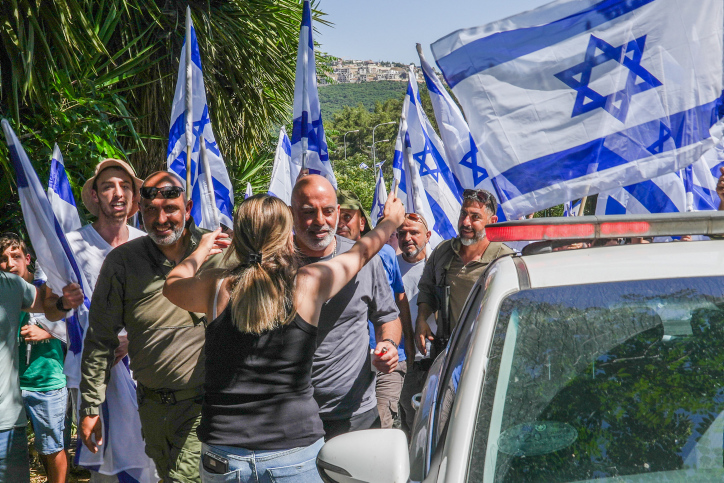Fathom’s new eBook, Rescuing Israeli-Palestinian Peace: The Fathom Essays 2016-2020, contains over 60 articles, reports and interviews. The editors believe it is the most comprehensive collection of constructive and expert reflections on the peace process to date and will be invaluable to peacemakers and analysts alike. It is a sequel to the 2015 Fathom eBook, Two States for Two Peoples – 20 Years after Oslo II: How to renew the peace process between Israel and the Palestinians which collected articles published between 2012-2015.
Part 1 includes essays analysing the events of the past year – the normalisation agreements, Netanyahu’s annexation talk, and the Trump Plan. Koby Huberman believes the agreement constitutes a potential game-changer for the region and if utilised correctly, could be the kickstart to a new initiative for a regional dialogue between Israel, the Palestinians and Arab states for the advancement of the two-state solution.
In an Open Letter following Prime Minister Boris Johnson’s warnings against annexation, Yossi Kuperwasser argues the unilateral application of sovereignty is necessary to move the peace process forward; Dore Gold, former Director General of the Foreign Ministry and long-time advisor to Prime Minister Netanyahu, sets out the case for Israel applying sovereignty. Drawing on his decades of experience in the security establishment, Amos Gilead, warns of the local, regional and international dangers of Israeli annexation; and Calev Ben-Dor reviews the Israeli debate about annexation and likely international reactions to it as well as mapping out the reasons for the its political rise in influence.
Alex Ryvchin argues the Palestinian rejection of the Trump plan is yet another catastrophic strategic mistake and once again represents the choice of ‘cause’ over statehood. Critical of the plan is Jack Omer-Jackaman who believes it to be an affront to Palestinian national rights and to a just Zionism; John Lyndon, who sees it as draining the two-state solution and the very idea of peace of all meaning and Michael Koplow who claims its construction and release could provide fuel for even more damaging developments.
Part 2 focuses on the (sometimes faulty) underlying assumptions of the political process. Toby Greene emphasises the importance of UN Security Council Resolution 242, which sets out rights and responsibilities for each side and anchors a requirement for an Israeli territorial withdrawal with the simultaneous reinforcement of Israel’s legitimacy and security. Yossi Klein Halevi argues that both sides need to stop the war on the legitimacy of each other’s narrative while offering a radically new kind of Israeli-Palestinian conversation about the conflict based on respect and deep mutual recognition. Orna Mizrahi details the factors in the Israeli-Palestinian arena, the region, and the international community that have disincentivised the sides to renew negotiations. Toby Greene describes the spectrum of opinions on the two-state solution amongst Israelis.
Two essays analyse the flaws of the traditional peace process paradigm which began in 1993. Einat Wilf writes that ‘Constructive Ambiguity’ ultimately became destructive and instead advances a model of ‘Constructive Specifity’, especially regarding final status issues such as Palestinian refugees and Jerusalem. Rabbi Michael Melchior, a former Deputy Foreign Minister, points to another lacuna of the peace process, namely the exclusion of religious leaders, and argues that religion can be a source of peace.
The erosion of the classic paradigm, which posited bilateral negotiations based on an ‘all or nothing’ agreement, has led other ideas to take centre stage in Israeli policy circles. Koby Huberman lays out a plan for including Arab states in Israeli-Palestinian talks so as to create greater incentives for mutual compromise. Asher Susser explains why the peace process is stuck and explains the logic behind Israeli unilateral moves. Former Defence Minister Naftali Bennett details his ‘Stability Plan’, which involves gradually applying sovereignty over Area C and giving the Palestinian ‘autonomy on steroids’. From the other side of the political spectrum, Dahlia Scheindlin explains how she came to support a confederative approach. The Israeli-Palestinian peace process: towards a hybrid approach summarises conversations from the Track 2 dialogue facilitated by BICOM and Chatham House in 2016 and suggests a hybrid approach, combining different strategies as a potential way forward. And Shany Mor provides a compelling critique of the one state proposed by Peter Beinhart (amongst others).
The many structural and ideological differences preventing a peace agreement coupled with increased fears of the slide towards a binational reality have driven policymakers and thinkers to prioritise keeping the ‘two-state solution window’ open. In separate essays, Dennis Ross and Michael Herzog, both veterans of negotiations spanning three decades, lay out ideas for what can and should be done now even without a return to bilateral negotiations. And Micah Goodman, author of the best seller Catch 67, The Left, the Right, and the Legacy of the Six-Day War, recommends specific Israeli policies that can shrink the occupation, even if ending it is not possible for the time being.
The section ends with two essays from different sides of the political spectrum. Writing ‘in praise of the status quo’ Shalom Lipner says the current situation is the best that can be hoped for the time being; and Tony Klug argues that while a two-state solution is the only plausible solution, it may no longer be feasible.
Part 3 focuses on Palestinian perspectives and the future of the Palestinian National Movement. Husam Zomlot, head of the Palestinian Mission to the UK, argues that the international community needs to play a more active role in the peace process. Lauren Mellinger identifies the constitutional crisis awaiting the Palestinians in the ‘After Abbas’ era, and the likely strategic direction the national movement may take. Hussein Agha, an advisor to Mahmoud Abbas and former negotiator, lays out the problems of the traditional peace process and seeks to chart a path forward. Ayman Odeh, the leader of the primarily Arab ‘Joint List’ in the Knesset, describes his vision for the Arab-Palestinian minority within Israel. Khaled Elgindy discusses his book Blind Spot: America and the Palestinians, from Balfour to Trump and describes the approaches that American administrations have taken to the Palestinians. Ziad Darwish warns that the time to rescue the two state solution is running out. In separate interviews, activists Aziz Abu Sara and Ali Abu Awad describe their journeys towards peace activism, while Professor Mohammed Dajani-Daoudi talks about his ideas to revive the Palestinian peace camp.
Doron Matza analyses the fraught relations between the Government of Israel and the Palestinian Authority, arguing that it actually reflects an informal ‘deal’ which includes turning the diplomatic arena into an ‘agreed conflict zone’. The last two essays in this section focus on President Mahmoud Abbas and the likely future of the Palestinian National Movement after he leaves the scene. Grant Rumley and Amir Tibon, the authors of The Last Palestinian: The Rise and Reign of Mahmoud Abbas, critically review the events that have shaped the political thinking of the Palestinian President, and assess the legacy he is likely to leave behind.
Part 4 drills down into the main core final status issues. Kris Bauman and Ilan Goldenberg, as well as Michael Herzog and Gershon Hacohen discuss Israeli security concerns and potential parameters for a security regime in a peace agreement. Einat Wilf explains why the United Nations Relief and Works Agency (UNRWA) perpetuates, rather than alleviates, the conflict by encouraging what she terms ‘Palestinian maximalism’. Meir Krauss, former head of the Jerusalem Institute for Policy Research, sketches contours for a potential agreement in the city. David Makovsky discusses settlements in the West Bank, warning that while they have not yet precluded separation between Israelis and Palestinians, the ‘door won’t always remain open’. Orni Petrushka and Gilead Sher (himself a former negotiator at Camp David), believe settlements have not made peace unachievable and present a plan to bring settlers back to within the Green Line. Sara Hirschhorn argues that in many cases, the American Jews who moved to the West Bank and Sinai in the early decades after the Six-Day War thought of themselves as idealists and liberals seizing an historic opportunity to create a ‘city on a hilltop’. Oded Haklai explains that the longer Israel holds on to the territories, the greater the number of Israeli Jews who accept control over them as the natural state of affairs.
Part 5 examines the importance of people-to-people peacemaking. John Lyndon argues that if the peace camp is to return to its height of the early 1990s, it must heed the lessons of long-termism adopted by the settler movement and re-learn how to implement real change in Israel. Noam Schuster-Eliassi, a graduate of the ‘School of Peace’ lays out principles for the Israeli peace camp to rebuild itself and expand its ranks. Nava Sonnenschein explains how she came to build ‘School for Peace’ and believes that Israel will eventually have to come to terms with its past if it wants to make peace and fulfil the Zionist dream of her parents. Shaul Judelman speaks about grassroots work to empower moderates and his journey to non-violent peace activism. We conclude this section by publishing the Executive Summary of a major Fathom report, written by Ned Lazarus, reviewing the history and current state of peacemaking and recommending a strategy for future progress. The full report is available online: A future for Israeli-Palestinian peacebuilding.
Part 6 looks at a range of feminist perspectives, Israeli and Palestinian, on peacemaking and the peace process. Sarai Aharoni discusses feminist peace movements and women’s participation in negotiations and decision making. Huda Abu Arqoub, the regional director of the Alliance for Middle East Peace (ALLMEP), talks about the challenges faced by a Palestinian feminist engaged in conflict-resolution activism; and Tirza Kelman reports on an organised visit to Northern Ireland to learn about what the peace process there can teach Israelis and Palestinians.
Part 7 takes a retrospective look at the Oslo Accords. Joel Singer, legal advisor to the Israeli delegation, provides his personal recollections of the Oslo process, Yair Hirschfeld, one of the two Israeli academics who engaged in initial conversations with the PLO, analyses lessons learned from that time; and Gilead Sher warns of the dangers of terminating the Accords. This section also includes a debate surrounding Seth Anziska’s book Preventing Palestine, A Political History from Camp David to Oslo. The book claims that the architecture of the Camp David Accords between Israel and Egypt undermined the possibility of meaningful sovereignty for Palestinians, although Joel Singer and Yair Hirschfeld – who were heavily involved in these accords – take issue with this argument.
We don’t expect readers – however avid – to go through all 462 pages! But with major changes afloat and traditional thinking in flux, we hope policy makers will find this collection useful in forging a path that offers a better future for Israelis, Palestinians and the entire Middle East. Ultimately, even with the many problems surrounding the two-state paradigm, we don’t believe any real-world alternative exists that can better fulfil the hopes and aspirations of both peoples.
Calev Ben-Dor, for the Editors

